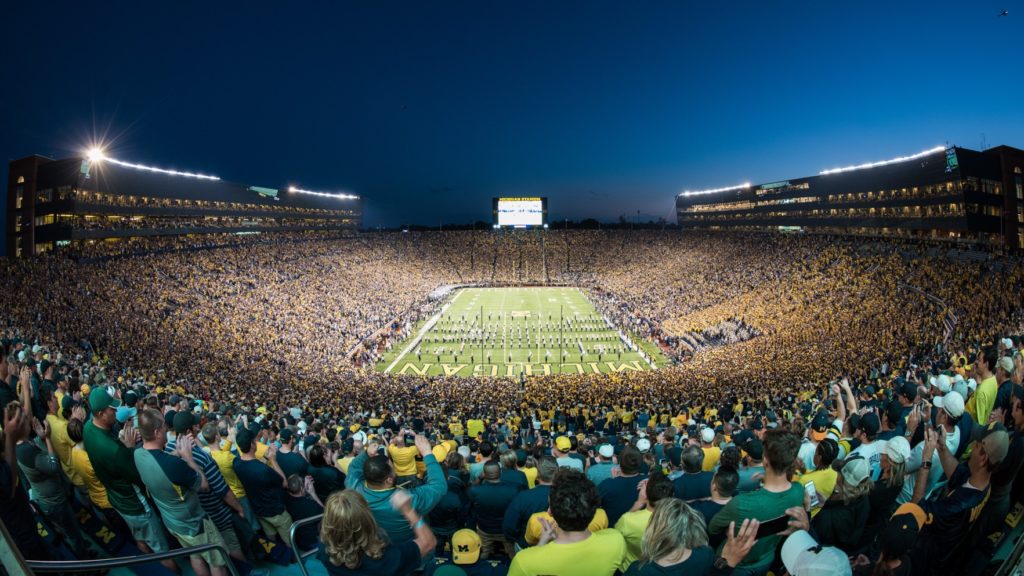What will happen to big time college sports during the pandemic?

This isn’t exactly the biggest problem facing the country at the moment by a damn sight, but it offers one glimpse into how thoroughly normal economic relations are getting disrupted.
Let’s take a look at the University of Michigan’s athletic budget. For FY2020 it features $196.3 million in revenues, and by a remarkable coincidence $196.3 million in expenditures. The FY2021 budget, which goes into effect in about ten weeks, isn’t publicly available, but based on long term trends it was probably slated to be about $210 million. Note: this is exactly ten times larger, IN CONSTANT INFLATION-ADJUSTED DOLLARS, than it was in fiscal 1976, when Sports Illustrated ran this profile of Michigan’s AD Don Canham. The premise of that story was that college sports were going broke, and that current spending trends were basically unsustainable.
Where is — or shall we say was — that money going? Using FY2019 figures as a baseline, the answer would appear to be that salaries and benefits are supposed to be around $75 million for the coming fiscal year, while student aid — athletic scholarships — are going to be about $32 million. Note that the Michigan AD is, or was, financially independent of the general university’s budget, so these scholarship payments were a non-trivial source of revenue to the university (The marginal cost of these scholarships to the university is fairly minimal, so billing the AD for them is essentially a bookkeeping device, to extract revenue from the AD to help pay for general university operating expenses).
The AD owes another $17.5 million in annual debt service for capital construction projects — primarily the $200 million dollar renovation of the football stadium that was completed a little more than a decade ago.
“Team and game expenses” make up about another $40 million — we can assume that most of these will not incurred if there are no games.
The ever-popular “other operating and administrative expenses” adds about $17 million to the total.
Facilities expenses are about $12 million: it’s unclear how much of these are going to be incurred even if there are no games, but since a lot of that money is probably dedicated to ongoing capital maintenance I would guess quite a bit.
There’s a bunch of other stuff but these are the big ones.
Now let’s look at the revenue side:
“Spectator admissions” were supposed to be about $60 million, give or take. Almost all of this was made up of football tickets, with maybe 7% being men’s basketball and 2% being the other 30 sports.
However this doesn’t include the revenue from what the university refers to primly as “enclosed seating,” but known less euphemistically as football stadium luxury boxes. These rent out at about $75K a pop, tickets not included. Nor does it include “preferred seating contributions,” which is the considerable fee — up to several hundred dollars per ticket — that football season ticket holders have to pay just to be eligible to pay for season tickets. (Until last year 80% of this fee was deductible as a charitable contribution to the university). These sources add up to about another $35 million.
Then we have “conference distributions,” which is the TV money from ESPN and the Big 10 Network that the Big 10 conference distributes to its member schools. This was going to be about $62 million in FY2021.
All of this — every last cent of ticket and luxury box and seat license and TV money — is going bye bye if there are no games (The TV contracts are carefully drafted by better lawyers than Richard Epstein to consider such eventualities. BTW the All-England Lawn Tennis Club — the holders of Wimbledon, paid $2 million a year for the last 17 years for pandemic insurance. When they cancelled the tournament earlier this month they were set to get a $141 million payoff from that policy. But remember that nobody could have foreseen anything like this pandemic).
The only sources of AD revenue that might survive intact a full cancellation of this year’s football and men’s college basketball seasons are corporate sponsorships and licensing fees, that together add up to about $30 million, but you can expect some nasty litigation about that.
Basically, the revenues for a $210 million annual operation are going to go to something very close to zero a few weeks from now. And something like this is happening at the several dozen college athletic departments that have nine-figure operating budgets. (This is why the ADs of these departments are desperately trying to figure out if they can somehow play games without spectators etc.).
I’m certainly not crying for football coach Jim Harbaugh and his eight million dollar salary, or for various other absurdly overcompensated beneficiaries of this exploitative system. But tens of thousands of ordinary AD employees across the country are suddenly not going to have paychecks, unless somebody figures out how to square this circle.
Similar stories are going to play out all over our $21 trillion economy over the next few months.


